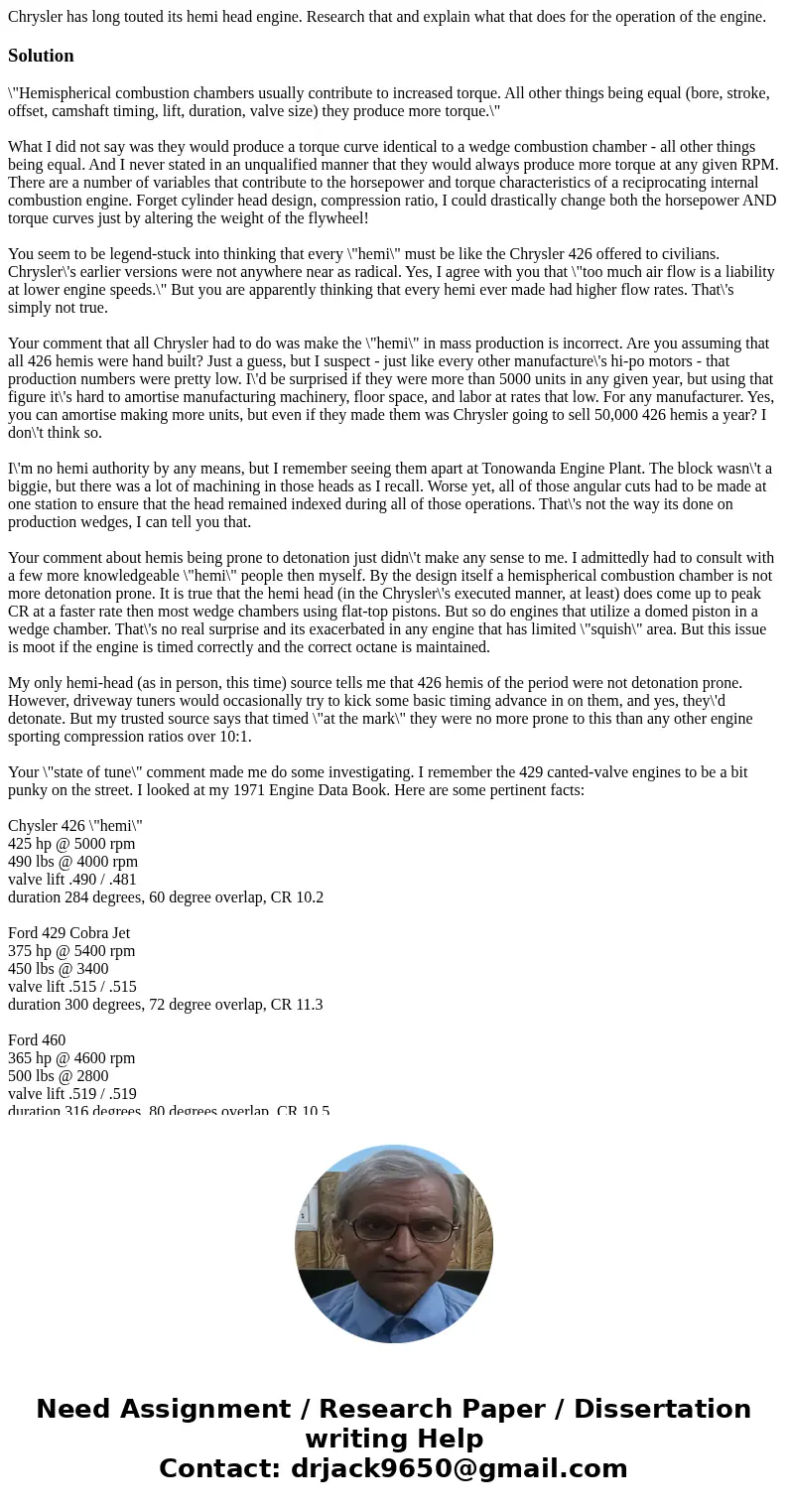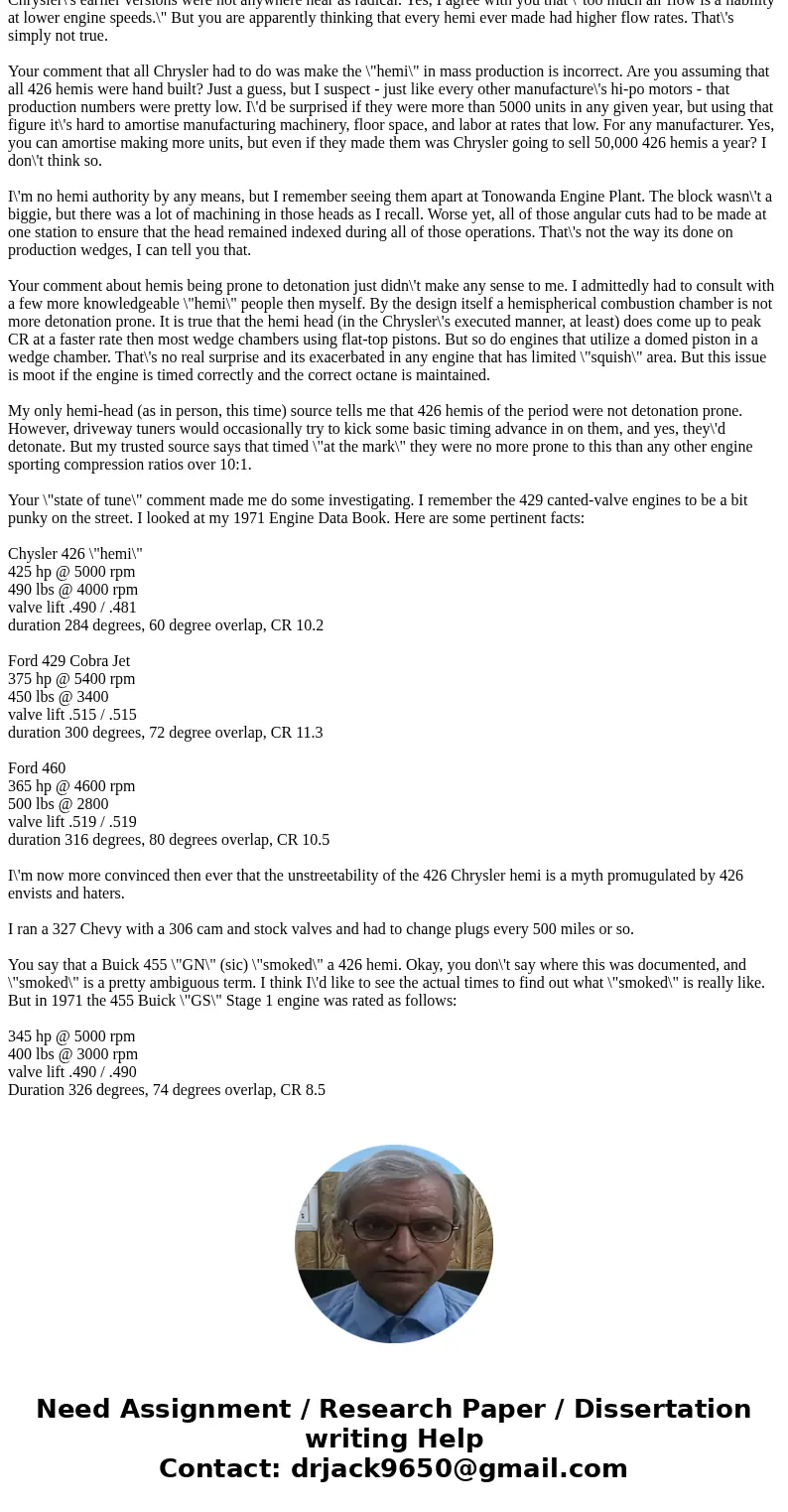Chrysler has long touted its hemi head engine Research that
Chrysler has long touted its hemi head engine. Research that and explain what that does for the operation of the engine.
Solution
\"Hemispherical combustion chambers usually contribute to increased torque. All other things being equal (bore, stroke, offset, camshaft timing, lift, duration, valve size) they produce more torque.\"
What I did not say was they would produce a torque curve identical to a wedge combustion chamber - all other things being equal. And I never stated in an unqualified manner that they would always produce more torque at any given RPM. There are a number of variables that contribute to the horsepower and torque characteristics of a reciprocating internal combustion engine. Forget cylinder head design, compression ratio, I could drastically change both the horsepower AND torque curves just by altering the weight of the flywheel!
You seem to be legend-stuck into thinking that every \"hemi\" must be like the Chrysler 426 offered to civilians. Chrysler\'s earlier versions were not anywhere near as radical. Yes, I agree with you that \"too much air flow is a liability at lower engine speeds.\" But you are apparently thinking that every hemi ever made had higher flow rates. That\'s simply not true.
Your comment that all Chrysler had to do was make the \"hemi\" in mass production is incorrect. Are you assuming that all 426 hemis were hand built? Just a guess, but I suspect - just like every other manufacture\'s hi-po motors - that production numbers were pretty low. I\'d be surprised if they were more than 5000 units in any given year, but using that figure it\'s hard to amortise manufacturing machinery, floor space, and labor at rates that low. For any manufacturer. Yes, you can amortise making more units, but even if they made them was Chrysler going to sell 50,000 426 hemis a year? I don\'t think so.
I\'m no hemi authority by any means, but I remember seeing them apart at Tonowanda Engine Plant. The block wasn\'t a biggie, but there was a lot of machining in those heads as I recall. Worse yet, all of those angular cuts had to be made at one station to ensure that the head remained indexed during all of those operations. That\'s not the way its done on production wedges, I can tell you that.
Your comment about hemis being prone to detonation just didn\'t make any sense to me. I admittedly had to consult with a few more knowledgeable \"hemi\" people then myself. By the design itself a hemispherical combustion chamber is not more detonation prone. It is true that the hemi head (in the Chrysler\'s executed manner, at least) does come up to peak CR at a faster rate then most wedge chambers using flat-top pistons. But so do engines that utilize a domed piston in a wedge chamber. That\'s no real surprise and its exacerbated in any engine that has limited \"squish\" area. But this issue is moot if the engine is timed correctly and the correct octane is maintained.
My only hemi-head (as in person, this time) source tells me that 426 hemis of the period were not detonation prone. However, driveway tuners would occasionally try to kick some basic timing advance in on them, and yes, they\'d detonate. But my trusted source says that timed \"at the mark\" they were no more prone to this than any other engine sporting compression ratios over 10:1.
Your \"state of tune\" comment made me do some investigating. I remember the 429 canted-valve engines to be a bit punky on the street. I looked at my 1971 Engine Data Book. Here are some pertinent facts:
Chysler 426 \"hemi\"
425 hp @ 5000 rpm
490 lbs @ 4000 rpm
valve lift .490 / .481
duration 284 degrees, 60 degree overlap, CR 10.2
Ford 429 Cobra Jet
375 hp @ 5400 rpm
450 lbs @ 3400
valve lift .515 / .515
duration 300 degrees, 72 degree overlap, CR 11.3
Ford 460
365 hp @ 4600 rpm
500 lbs @ 2800
valve lift .519 / .519
duration 316 degrees, 80 degrees overlap, CR 10.5
I\'m now more convinced then ever that the unstreetability of the 426 Chrysler hemi is a myth promugulated by 426 envists and haters.
I ran a 327 Chevy with a 306 cam and stock valves and had to change plugs every 500 miles or so.
You say that a Buick 455 \"GN\" (sic) \"smoked\" a 426 hemi. Okay, you don\'t say where this was documented, and \"smoked\" is a pretty ambiguous term. I think I\'d like to see the actual times to find out what \"smoked\" is really like. But in 1971 the 455 Buick \"GS\" Stage 1 engine was rated as follows:
345 hp @ 5000 rpm
400 lbs @ 3000 rpm
valve lift .490 / .490
Duration 326 degrees, 74 degrees overlap, CR 8.5


 Homework Sourse
Homework Sourse